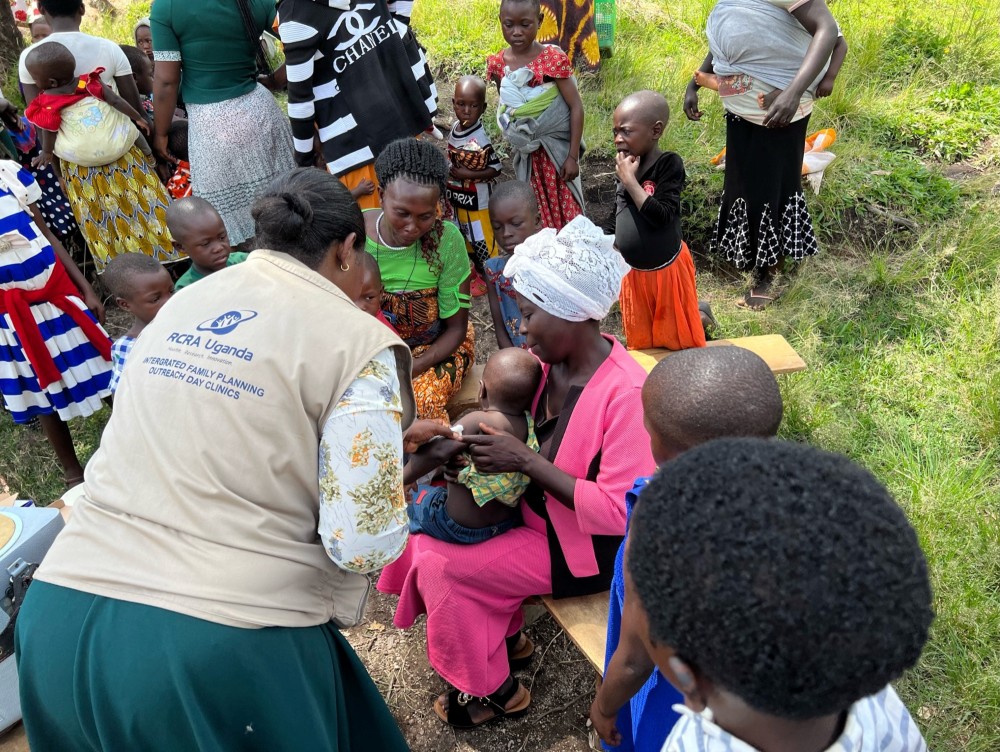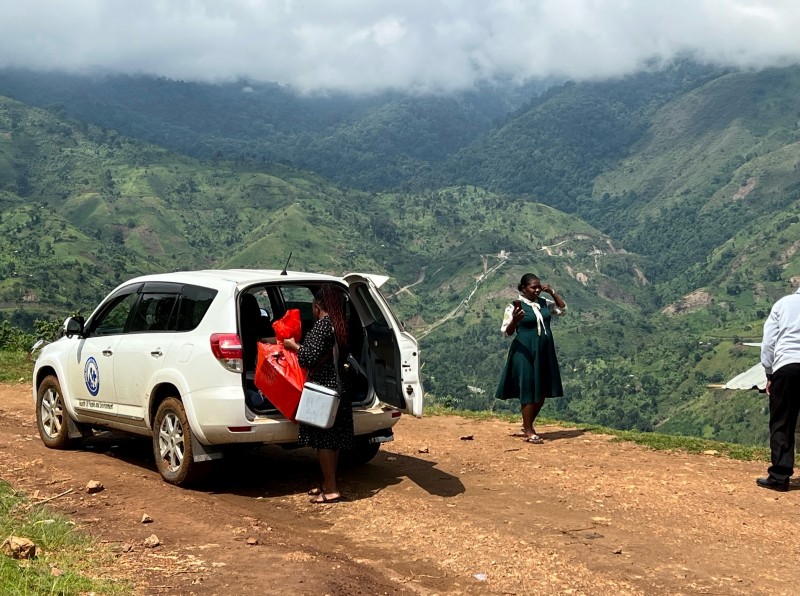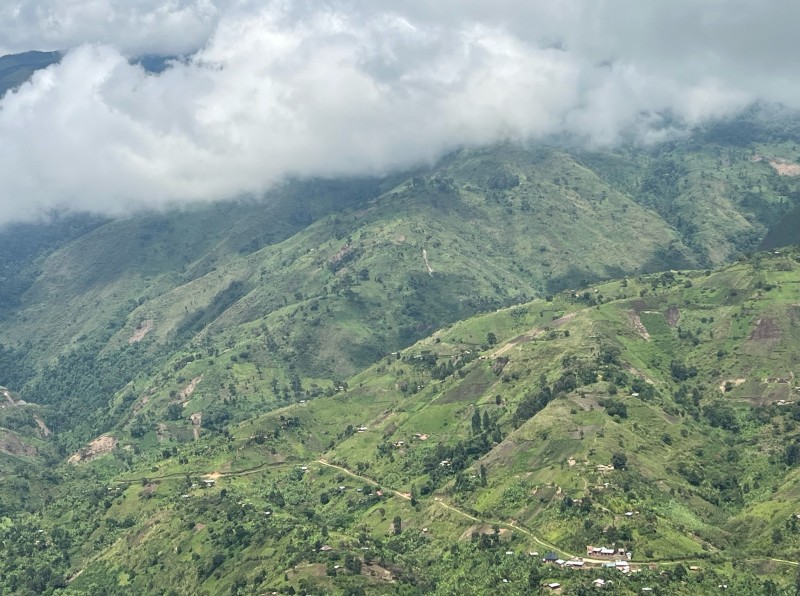
A Women-Led Approach to Building Resilience in Uganda
January 4, 2023
By: Elizabeth TullyJared Sheppard
This post was originally published on the Knowledge SUCCESS website. To view the original post, click here.
The Rwenzori Center for Research and Advocacy, founded in 2010, is a Ugandan NGO that serves women, children, and adolescents in the poorest communities to help them access improved livelihoods, including better health care and education. We sat down with Jostas Mwebembezi, Executive Director and Founder, to learn more about the work his organization is doing, specifically for Population, Health, and Environment (PHE) programming.
What steered you towards the PHE approach?
Before PHE, I was working in different sectors and in individual sectors. For example, we did maternal and child health—preventing maternal death, increasing healthcare-seeking behavior, supporting women’s access to antenatal care with information about how to feed their babies, how to address low birth weight, and also ensuring that they have deliveries that are facilitated by a skilled professional.
So we would only look at supporting them with information and not giving them all other interventions that would perhaps support them with information about improving nutrition, but would not support them with kitchen gardens. After we learned about PHE, which is really very interesting—it’s not about one intervention, but a combination of interventions at [the] household level, attached to a number of sustainable development goals. So this really accelerated our interest in implementing PHE and to date, we have a number of households that are having PHE interventions at-hand. So we see this as a great model and what defines our work in the community. It’s what makes us unique because we deliver multi-sectoral interventions at once.
The households that you mention, were those connected to the model households that originated from the HoPE-LVB project?
Yes, we started with a few model households where we were able to implement PHE interventions, but over time, since 2017, we have expanded the model into other communities, into other households. The households welcome all the PHE interventions. When we speak about PHE, they really love the concept because it gives them all things at once. For example, going to the household to offer education—the community health worker offers environment and maternal and child health education, including sexual and reproductive health and rights. So when they’re going to offer short-term methods for family planning, they also teach the household about tree planting and even give them trees for planting. So it’s an integrated model and different referrals are all made.
So our home visits go in a multi-sectoral approach whereby the community health workers are able to offer education about family planning, biodiversity, tree planting, the energy-saving stoves, as well as maternal and child health, including newborn care, which gives the household benefits. Beyond communication, it’s also about the action—so we teach them about nutrition, we give them kitchen gardens, we teach them how to nurture the kitchen gardens, and how they regenerate. We also teach them about family planning and offer them methods.
Do these community health workers go through more training than you would typically see in a health worker that just would focus on delivering family planning counseling?
Yes, our community health workers are taken through a rigorous training, which takes almost a whole week. They are taught about the integration and they do their normal door-to-door visits and referrals. But with the PHE component, we take them through the deliverables for them to establish the model households. We teach them about family planning information and also integration of family planning, nutrition, and climate change—and how they bring one package to a household when they’re making outreaches. They undergo different trainings and we assess them and see their knowledge about the uptake of family planning, nutrition, as well as climate resilience at the household level. So we send them to the community when they’re really prepared and know they’re really going to deliver and they’re delivering great work in the community.

Is your organization solely doing the model households or do other organizations have that type of PHE model that they’re working through as well?
Other organizations have single implementation. For example, other organizations support the household with seedlings for planting and it ends there. Our household intervention comes with seedlings, kitchen gardens, dry rack (to sun-dry household utensils), energy-saving stoves, and education on maternal and child health. It also comes with tree planting, so all in one. This provides the household [with] all the services at one visit and the households in the communities where we are working, they have more benefits from the project than other households.
For example, the households we are serving are no longer depending on markets for vegetables. Actually, they support markets with vegetables from their gardens. So we asked them, “How long since you have been to the market?” And they say they don’t remember when they went to buy cabbage, they don’t remember when they went to buy sukuma wiki, they don’t remember when they went to buy tomatoes and onions. This makes us [happier] because the income, the money they used to spend on cabbages and so on, can now be spent on other domestic basic needs at household level.
How many communities are you reaching in Uganda?
We are working in Kasese, some in the neighboring district of Bunyangabu, and in the Kyaka II refugee camp in Kyegegwa. Kasese is where we have a strong presence in all sub-counties for our projects, family planning outreach clinics, and door-to-door goes up to 15 sub-counties, which are very remote. Kasese is one of the largest districts in the country with a population close to one million people. So PHE has gone so far.
What are the largest challenges you are facing within your PHE work?
One of the largest challenges is seeing a great need from the local leaders who have seen the goodness of PHE. They feel they need an expansion, and that more households should be included, but the resources we have do not allow us to reach that wider scale of beneficiaries and the scale of households, which really would benefit from similar interventions because PHE has proven to be effective in improving food security and improving the healthcare-seeking behavior at household levels, improving the uptake of low-cost climate change interventions such as planting trees for fruit and for wood. We support women to reduce consumption of wood by using a lorena stove, but also to plant trees so they now do not have to go to the forest to look for wood.Our tree planting is to expand to one million trees over the coming years.
Do you have any innovations in PHE that your organization is working on?
Yes. The innovations we are looking at now, we are now calling Women-Led Community Resilience and Development. It’s our approach to another way of branding PHE. We are now utilizing the kitchen garden as a platform for information sharing, so women gather around the kitchen garden to learn about family planning, to learn about short-term methods, and also be able to know where they can access those methods. Our community health workers are able to reach out to the gatherings with short-term methods and if a woman is interested in a long-term method, they are given a referral form.
The kitchen garden is now beyond vegetable consumption, and [is] now a knowledge-sharing platform where gardeners gather and learn about climate change and learn about all other interventions through the Women-Led Community Resilience and Development. So, that’s something that really has helped us to increase the networking of the gardeners and also to see gardeners learn from each other with how vegetables are growing. We are looking at vegetables, growing healthily without chemicals; all our gardeners do not use chemicals, and they’re able to really have better outcomes from their vegetable gardens.

Do you find that men are receptive to the Women-Led Community Resilience and Development or have you gotten any pushback?
No, men are really very grateful, because their interpretation is that women are the ones who are feeding the home, so they’re always seeing women preparing meals, bringing meals on the table, making their gardens, and then nurturing their gardens, so we are seeing great collaboration between women and men. We have not seen any evidence where men are against the activities, and we’re seeing men are doing a great job in helping women identify a method for family planning. So, the male involvement is really helpful in our interventions and especially when we reach households, we ask our community health workers to engage males and to engage the heads of the family for consent. Men are very glad to see women are taking on interventions at household level.
Do you engage young people at all in the work that you’re doing?
Yes, the adolescents are at the center of our work and we have adolescents in different groups. We are targeting adolescents aged 10 to 19 years. We have established an adolescent center at our Health Center Three that provides a number of services for adolescents. This includes learning about computer skills, but also they learn about family planning. We have a pool table where adolescent boys come and play, and from time to time, a nurse will pause their game and teach them about family planning, and how they can protect girls from unwanted pregnancies and so on. If they want to know their HIV status, the services are all free for them, they’re going to be able to access that.
Then we have tailoring machines for our adolescent girls who are able to make [menstrual] pads. These pads they make are later given out freely to adolescents who are in schools, so we’re able to engage adolescents in all those aspects. We have the younger mothers who are the master trainers in the making of pads. The younger mothers are also beneficiaries for our model households who benefit from the kitchen gardens and we are seeing success stories that their babies are now looking healthy and mothers feel they have no stress [about] where to get vegetables.
What does your day-to-day look like as Executive Director in all of this work? Are you able to go into the communities and see the work or do you find yourself stuck in meetings and behind a desk a lot of the time?
For me, I’m on the ground doing work. Most of the time I’m in the community and outreach clinics; I’m always there with the teams arranging different service points and directing people to different service points. I reach households and I’m able to see the work the organization is doing directly in the community. I’m a statistician by profession, so I find it very helpful to continue my monitoring and evaluation and see things that we have planned in the office. I’m able to track those indicators and see how the indicators are performing and how people are getting services and collect feedback from the communities. So, I’m also able to interact with the beneficiaries and get feedback about how the programs are moving. This in turn, helps me to know if the program is really doing great for the community or if there’s a need for expansion to other communities. So staying in the community with people generates even more ideas from the community and their perception about PHE. There are so many who want the services expanded to their communities, but unfortunately the resources are challenging and we cannot reach all the households that really require these services.
Is there anything else you’d like to share about the work of your organization?
Beyond these interventions, we are implementing a project on HIV where we are enrolling patients who are HIV-positive and on treatment. We are tracking them to see if they achieve viral load suppression, and in other communities we do door-to-door HIV testing; those who are positive, we directly refer them for medication and then follow them over time, to see if they achieve viral load suppression.
We support them with other household interventions for economic strengthening. We train them in liquid soap making, which also links with PHE, and then also we have the Grandmother’s Program, where we’re able to support them with access to livestock, support them with access to scholastic materials, and pads for adolescents.
We have established the Health Center Three that now offers direct medical services and we have the staffing already in the facility. It is registered with the Minister of Health and the District, so we are also operating an adolescent center within the facility in the same areas where we have established a tree planting hub. Here, we’re looking to put up beds that will accommodate one million seeds of different tree species that we will give out to the community for free.The distribution of these trees will be through women’s community groups, linking back to the Women-Led Community Resilience and Development. We also have the village serving groups, which are led by women in the community, so all our work is entirely led by women in the communities.
We also have the Orphans and Vulnerable Children Program moving forward.To date, we have 544 households of vulnerable children who are HIV-positive under our care, and we’re delivering a number of interventions to these households.
Beyond that, we are looking to expand our Health Center Three to a specialized hospital for women and children. So, now we will have our ideas incorporated while we expand our PHE interventions to new communities, including the refugee camps in the region.
To learn more about the Rwenzori Center for Research and Advocacy, please visit their website.



